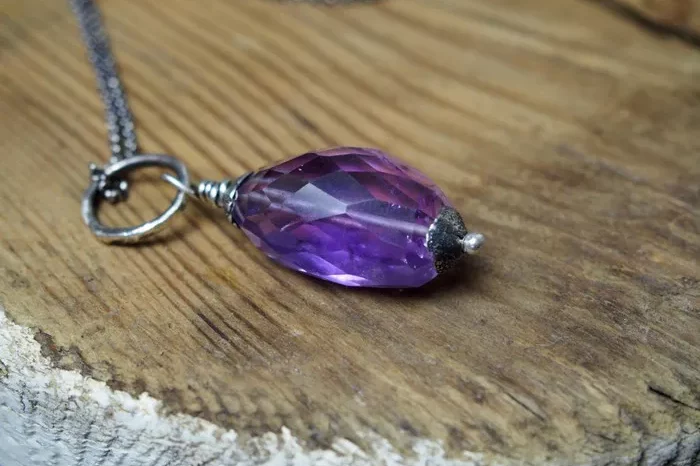Amethyst jewelry, renowned for its captivating violet hues and mystical aura, has been cherished for centuries across various cultures. This semiprecious gemstone belongs to the quartz family and is known for its hardness, durability, and unique coloration. Amethyst necklaces, in particular, are a popular choice among jewelry enthusiasts due to their elegance and versatility. However, the question of whether it is advisable to wear an amethyst necklace while showering often arises among owners. To provide a comprehensive answer, it is essential to understand the properties of amethyst, the potential risks associated with exposure to water and other elements, and best practices for maintaining amethyst jewelry.
Properties of Amethyst
Hardness and Durability:Amethyst has a hardness rating of 7 on the Mohs scale of mineral hardness, which makes it relatively durable and scratch-resistant. However, it is still softer than some other gemstones like diamonds or sapphires, which have higher hardness ratings. This means that while amethyst can withstand moderate wear and tear, it is susceptible to damage from harder substances or rough handling.
Color and Clarity:The vibrant violet color of amethyst is due to trace amounts of iron and aluminum in its crystalline structure. The color can range from light lavender to deep purple, with the most valuable stones typically exhibiting a rich, even tone. Clarity refers to the internal flaws or inclusions within the gemstone. Amethyst can have various levels of clarity, from nearly flawless to heavily included. While some inclusions can add character to the stone, they can also weaken its structure and make it more susceptible to damage.
Porosity and Chemical Sensitivity:Amethyst, like many gemstones, is not completely impervious to chemicals. Its porosity, although relatively low compared to some other gemstones, means that it can absorb certain substances over time. Exposure to harsh chemicals, such as those found in cleaning products or personal care items, can cause discoloration or damage to the gemstone.
Risks of Showering with an Amethyst Necklace
Water Exposure:While amethyst is generally stable in water, prolonged exposure or exposure to hot water can cause subtle changes in its appearance. Hot water can cause the gemstone to expand and contract, leading to cracks or fractures over time. Additionally, the soap and shampoo used in showers often contain chemicals that can be harmful to gemstones. These chemicals can build up on the surface of the amethyst, dulling its shine and potentially causing discoloration.
Physical Impact:Showering involves physical movements that can cause the necklace to rub against the skin, hair, or shower surfaces. This friction can scratch the surface of the amethyst or loosen the settings of the necklace, leading to potential loss of stones. Furthermore, if the necklace gets caught on something in the shower, it could break or cause injury.
Temperature Changes:The rapid temperature changes that occur in a shower environment can also be detrimental to amethyst jewelry. Sudden shifts from cold to hot can cause the gemstone to expand and contract unevenly, leading to internal stress and potential cracking.
Best Practices for Maintaining Amethyst Jewelry
Removing Jewelry Before Showering:To minimize the risks associated with showering with an amethyst necklace, it is recommended to remove the jewelry before entering the shower. This simple step can prevent exposure to water, chemicals, and physical impact, all of which can damage the gemstone.
Cleaning and Care:Regular cleaning is essential for maintaining the beauty and longevity of amethyst jewelry. Use a soft cloth and warm water to gently wipe down the gemstone and metal settings. Avoid using harsh chemicals or abrasive materials, as these can scratch or damage the surface of the amethyst. For stubborn dirt or grime, a mild soap solution can be used, but it is important to rinse thoroughly and dry the jewelry completely after cleaning.
Storage Considerations:When not wearing your amethyst necklace, store it in a soft cloth or jewelry box to prevent scratches and protect it from dust and dirt. Avoid storing it in direct sunlight or extreme temperatures, as these can cause discoloration or damage to the gemstone.
Professional Maintenance:Even with regular at-home care, it is advisable to have your amethyst jewelry professionally inspected and maintained at least once a year. A professional jeweler can check for loose settings, clean the gemstone and metal thoroughly, and provide recommendations for further care.
Understanding the Impact of Different Showering Conditions
Water Temperature and Pressure:The temperature and pressure of the water in your shower can affect the durability of your amethyst necklace. Hot water and high pressure can exacerbate the expansion and contraction of the gemstone, increasing the risk of cracking. It is best to use lukewarm water and a gentle flow when washing your body to minimize stress on the jewelry.
Shampoo and Conditioner:The chemicals in shampoo and conditioner can be particularly harmful to gemstones. These products often contain sulfates, parabens, and other ingredients that can build up on the surface of the amethyst, causing dullness and discoloration. Rinsing the necklace thoroughly after accidental exposure can help mitigate some of these effects, but it is still best to avoid wearing it in the shower altogether.
Shower Accessories:Shower curtains, hooks, and other accessories can pose a risk to jewelry. The necklace can easily get caught on these items, leading to damage or loss. Be mindful of your surroundings and remove the necklace before engaging in any activities that could put it at risk.
Conclusion
In conclusion, while amethyst jewelry is beautiful and durable, it is not ideal for wearing in the shower. The combination of water, chemicals, physical impact, and temperature changes can all contribute to damage to the gemstone and metal settings. By following best practices for maintaining amethyst jewelry, including removing it before showering, regular cleaning, and professional maintenance, you can ensure that your amethyst necklace retains its beauty and value for years to come. Remember, the best way to protect your investment in fine jewelry is to treat it with care and respect, and to avoid exposing it to potentially harmful conditions.
Related topic:


